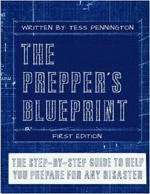
*Originally posted at Ready Nutrition by Tess Pennington
The overall goal of our emergency food pantry is to have a wide array of nutritious foods stored away in order to carry us through an emergency. In my book, The Prepper’s Cookbook, I wrote how firmly I believe in each household having an emergency food pantry. Whether those emergencies are from Mother Nature or if we have hit a rough patch in our lives, having food on hand will be less burdensome and will help free up money for other living expenses. The key is to a well-stocked pantry is to have lots of nutritious shelf stable foods at your disposal. Foods filled with lots of nutrition will carry you farther in an emergency than lots of junk foods.
The Meat and Potatoes of a Prepper Pantry
Over the years, I have made recommendations for the best types of foods to put in your pantry, how to save on emergency food stores by learning how to can and dehydrate your own food sources, as well as provided the best rules to go by when creating an emergency food pantry. Ideally, you want the food you put in those coveted pantry spots to be versatileand serve many uses.
I like to start with shelf stable basics like wheat berries, rice, an assortment of beans, dry milk powder, peanut butter, drink mixes, etc., and then add-on to my pantry with home canned and dehydrated foods. This creates layers of different types of short and long-term food stores and gives me more functionality in my pantry. Having layers of different food sources as coincides with the prepper rule of having back-ups for your back-ups. Here is a shopping list that first-timers can use to get a pantry started. Keep in mind this is for one person. If you have additional family members, use this calculator to add-on appropriately. Another way to add essential vitamins and nutrients to your food supply is to stock up on sprouting seeds. Inside these small biogenic (living) foods lies essential nutrients and vitamins that can assist in providing a good portion one’s daily requirement of nutrients. Sprouts can grow anywhere, during any season, and requires minimal work.
Where To Get Bulk Pantry Foods
As many of you know, preparedness is an investment and doesn’t always come cheap. One of the best places to buy bulk shelf stable foodstuffs that I have found is at the LDS food storage warehouses. I am not Mormon, but this church has opened its doors to non-members in order to create a more prepared community; and I am very thankful for this. I am able to purchase cases of canned beans, rice, dry milk, etc. and it’s already packed and ready for long-term storage. This frees up so much time! Here’s a link to their locations. As well, purchasing the larger, bulkier bags at Sam’s or Walmart is also very economical, but make sure you transfer your food items into long-term storage containers to protect your food investment. As well, don’t forget about storing water or having a way to treat it – this is crucial to survival.
Other Food Pantry Items
As I mentioned earlier, we like to layer our preparedness pantry. I buy meat on sale and freeze or can it for a later date. As well, we stock up on freeze-dried foods. For my family, freeze-dried foods are our last resort. If we run out of our pantry items, and our garden fails, only then do we turn to our freeze-dried food supply. My purpose in this is that I don’t want to solely rely on this type of emergency food source. I’m thankful it has a 25-year shelf life, but there are a lot of preservatives in freeze-dried foods that can cause constipation and stomach upsets. Therefore, I want to have enough of the natural foods my family normally eats before I turn to my freeze-dried foods. In addition, I also have garden seeds on standby so that we can grow a garden immediately if there is a widespread event.
Hopefully, this primer will get you started on your food pantry endeavors. As well, here are some additional articles to help you create a long-lasting and dependable food pantry.
11 Emergency Foods That Last Forever
Five Family Friendly Food Pantry Organizing Tips Anyone Can Do
5 Ways to Stretch Your Meals SHTF Style
Food Pantry: Take Care of Your Basic Needs
72 Hours Without This Will Kill You: Survival Water Fundamentals
Those of you who plan to take the first steps toward preparing for emergencies may feel a bit overwhelmed at first. After all, there is a lot of food to choose from at the grocery stores. We all know how confusing it can be getting started and luckily, there are lots of articles from Ready Nutrition and other great prepping websites to help with that.
Tess Pennington is the author of The Prepper’s Blueprint, a comprehensive guide that uses real-life scenarios to help you prepare for any disaster. Because a crisis rarely stops with a triggering event the aftermath can spiral, having the capacity to cripple our normal ways of life. The well-rounded, multi-layered approach outlined in the Blueprint helps you make sense of a wide array of preparedness concepts through easily digestible action items and supply lists.
Tess is also the author of the highly rated Prepper’s Cookbook, which helps you to create a plan for stocking, organizing and maintaining a proper emergency food supply and includes over 300 recipes for nutritious, delicious, life-saving meals.
Visit her web site at ReadyNutrition.com for an extensive compilation of free information on preparedness, homesteading, and healthy living.
This information has been made available by Ready Nutrition









